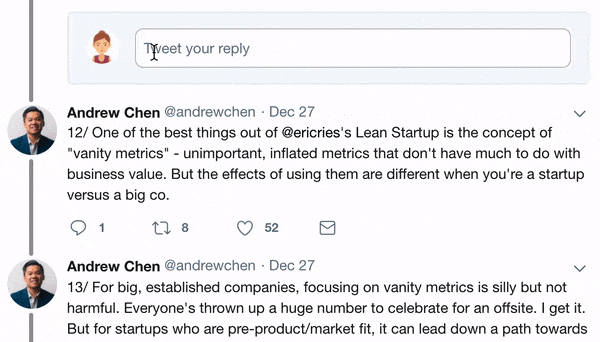
Tools like Roam and Obsidian are exciting because they facilitate so many different types of text-based workflows. However, I frequently see people comparing apples and oranges when trying to discuss which tools and workflows are "better."
https://twitter.com/maggied/status/1396104507432574980
Let's say we care most about non-fiction, argument based writing. I argue that creative outputs in this genre are composed of six different processes, each with "flagship" workflows. These processes facilitate the ultimate goal of writing: creation.
The key processes of non-fiction writing include:
1. learning (spaced repetition)
2. distilling (progressive summarization)
3. connecting (zettelkasten)
4. thinking (journaling)
5. synthesizing (evergreen notes)
6. creating (constraints)
1. learning (spaced repetition)
2. distilling (progressive summarization)
3. connecting (zettelkasten)
4. thinking (journaling)
5. synthesizing (evergreen notes)
6. creating (constraints)

Let's start with learning. When encountering new information, we need to understand it before we can use that information to create novel insights. There are a lot of ways to learn things; the most popular technique I see discussed in the PKM space is spaced repetition.
But learning is also facilitated by every other process as well (e.g. connecting what you've learned to other material helps with recall and can develop deeper insights for synthesis).
Tools for spaced repetition include: Flashcards (yes, paper!), @AnkiApp,@Rem_Note, @NeuraCache, roam/sr.
General spaced repetition references: andymatuschak.org/prompts/, super-memory.com/articles/20rul… (h/t @roamhacker), gwern.net/Spaced-repetit…
Distillation is about identifying the most important components of what you have read. The most popular technique of doing this is called progressive summarization (a technique developed by Tiago Forte @fortelabs and taught in his course Building a Second Brain).
Progressive summarization involves taking multiple passes (hence the "progressive" part) to succinctly describe the key points of a text. fortelabs.co/blog/progressi…
I see distillation as distinct from other processes like learning and synthesis. Many critiques of progressive summarization are based not on its ability to distill, but are because it isn't facilitating learning. I don't think that is the primary goal of the process.
Connecting is about relating what you know with other things you know. This is helpful to generate new ideas, leading to synthesis and creation, and also to reinforce learning and to help with distillation. However, again, it is distinct.
The most commonly discussed method for connecting ideas is the zettelkasten, but other techniques such as mind maps can also be helpful.
Resources for zettelkasten: zettelkasten.de, How to Take Smart Notes by @soenke_ahrens, @beauhaan's work with @RoamBookClub, thrivinghenry.com/writings/roamk…
Tools for mind mapping: @figjam, @scappleapp, @mindnode, @ConceptsApp (used also to brainstorm this post!)
Now let's talk about thinking. While we might think of many of the other processes I'm discussing as "thinking," in this case I am describing thinking specifically as the meta work of processing inputs and getting "unstuck." It helps facilitate the other writing processes.
One of the best ways to think is through journaling. Journaling is beneficial for everything from processing emotions to "flushing the pipes" when beginning a writing session to project management.
Resources for journaling: 750words.com, The Artist's Way Morning Pages, @tracyplaces and rebootspodcast.podia.com/roaman-journal…, betterhumans.pub/replace-your-t…
Synthesizing is about bringing together disparate sources and/or ideas to create new insights. It can be enabled by other methods, such as connections in a zettelkasten, but it "sits on top" of those connections.
When I think of synthesis I think of synthesis notes (@joelchan86) and Evergreen Notes (@andy_matuschak). Synthesis is about describing a clear idea that can be represented in a (atomic) succinct note, with supporting evidence as applicable.
Resources for synthesis: oasislab.pubpub.org/pub/54t0y9mk/r…, notes.andymatuschak.org/About_these_no…
Finally we have what people probably think about most when we talk about writing: creating. Creating is about using what you've learned, distilled, connected, thought, and synthesized and bringing something new into the world, whether it be a journal article or a tweetstorm.
One of the best ways to facilitate creation is through careful use of constraints. This could be something like publishing regularly to build a writing habit to submitting to a journal with a set of editorial standards.
https://twitter.com/ShanaPote/status/1379508573684826118
Resources for creating:
https://twitter.com/cortexfutura/status/1396459286604169217, @NaNoWriMo, #ship30for30, #1000wordsofsummer
Understanding the distinct processes involved in writing helps us figure out how to get the most from our tools and workflows. These processes need to be employed to help you reach your own goals, whatever they may be.
For example, people who want to "learn in public" are focusing on learning and creating to facilitate deeper understanding and connect with others.
Creation is essential for publishing academic articles, but other processes like connection and synthesis (and even learning) facilitate better insights for that work. Too much focus on connection and synthesis might be procrastination, but not enough can also be detrimental.
Understanding processes means evaluating them based on their affordances, and not comparing e.g. zettelkasten and spaced repetition. One emphasizes connecting and the other is mostly about learning. They both make sense in different contexts.
The beauty of tools facilitating multiple of these processes at once is that they make the different parts of the writing process explicit, but that doesn't mean that they all need to be deployed all the time.
When working on a project in my core discipline, I probably don't need to spend a lot of time reviewing flashcards about common terms. However, I might need to focus more on learning when working in a new field.
Ultimately, it's up to you the user to think about how to best employ these different processes. And maybe try some journaling if you're stuck 😉
In addition to all those cited above, thanks also to @cicatriz, @rossopeter_, @wm_dima, and Isaac Mathew for discussions that inspired this post.
found you Isaac, thanks @pinkrhinonet :)
• • •
Missing some Tweet in this thread? You can try to
force a refresh



